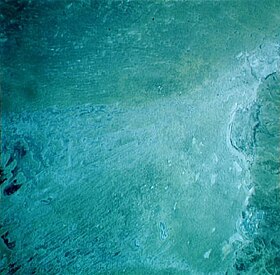Lake Callabonna is a dry salt lake with little to no vegetation located in the Far North region of South Australia. The 160-square-kilometre (62 sq mi)[1] lake is situated approximately 120 kilometres (75 mi) southwest of Cameron Corner, the junction of South Australia, Queensland and New South Wales. It is also known as Lake Mulligan.[2]
| Lake Callabonna | |
|---|---|
 Lake Callabonna from space | |
Location in South Australia | |
| Location | Far North, South Australia |
| Coordinates | 29°43′S 140°05′E / 29.717°S 140.083°E |
| Type | Salt lake |
| Basin countries | Australia |
| Designation | Strzelecki Regional Reserve (only partially) Lake Callabonna Fossil Reserve |
| Surface area | 160 km2 (62 sq mi)[1] |
The lake is an important site for late Pleistocene fossils. It is within the extent of the Strzelecki Desert Lakes Important Bird Area, identified as such by BirdLife International because of its importance for waterbirds when holding water in the aftermath of floods.[3][4]
History
editThe first pastoralists in the area were the Ragless brothers in 1881, who moved there from the northern Flinders Ranges, opening a sheep-run. The station owner in 1892, F. B. Ragless, was shown a number of giant skeletons embedded in the dry surface of the lake, discovered two days before by an Aboriginal station hand named Jackie Nolan. The South Australian Museum sent a worker, H. Hurst, to investigate the site. Four months later the results were delivered to the museum.[5]
After examination of the skeletons an expedition funded by Sir Thomas Elder and E. C. Stirling, director of the South Australian Museum, was organised and Hurst led the team back to the site.[5] After several visits, Stirling and A. H. C. Zietz collected a large number of diprotodon and dromornithidae skeletons. The area was designated a Fossil Reserve in 1901. Access is restricted.
Protected area status
editStrzelecki Regional Reserve
editThe northern end of Lake Callabonna is within the boundary of the Strzelecki Regional Reserve.[6]
Lake Callabonna Fossil Reserve
editLake Callabonna is the location of a site where the “articulated skeletons of Diprotodon,” an extinct genus of marsupial, were found in the late 19th century by the South Australian Museum. The site is considered to have “a very high palaeontological significance.” A fossil reserve was dedicated in 1901 under state law, which is in force, as the Crown Lands Act 1929. Administrative responsibility lies with the South Australian Museum.[7]
In 2002, it pointed out that the lake received “negligible management effort as a Fossil Reserve under the Crown Lands Act 1929” and that proclamation under the National Parks and Wildlife Act 1972 may provide a higher level of protection against “degradation arising from uncontrolled access.”[8] It was listed on the South Australian Heritage Register in February 1997.[9]
See also
edit- Genyornis newtoni, a species of large flightless bird which lived at Lake Callabonna
General:
References
edit- ^ a b "Map of Lake Callabonna, SA". Bonzle Digital Atlas of Australia. Retrieved 17 August 2015.
- ^ "Lake Callabonna, feature SA0011652", Gazetteer of Australia
- ^ "Lake Callabonna Reserve, Mount Hopeless via Lyndhurst, SA, Australia". Australian Government, Department of Environment. Retrieved 4 February 2015.
- ^ "IBA: Strzelecki Desert Lakes". Birdata. Birds Australia. Archived from the original on 6 July 2011. Retrieved 25 October 2011.
- ^ a b Vickers-Rich, P. (1993). Wildlife of Gondwana. NSW: Reed. p. 54. ISBN 0730103153.
- ^ ""Figure 2 Lake Frome & Strzelecki Regional Reserves, Land Systems" from A Review of Lake Frome and Strzelecki Regional Reserves – 1991 – 2001" (PDF). Department for Environment and Heritage. 2002. Retrieved 13 September 2015.
- ^ "A Review of Lake Frome and Strzelecki Regional Reserves – 1991 – 2001" (PDF). Department for Environment and Heritage. 2002. p. 7. Retrieved 13 September 2015.
- ^ "A Review of Lake Frome and Strzelecki Regional Reserves – 1991 – 2001" (PDF). Department for Environment and Heritage. 2002. p. 7. Retrieved 13 September 2015.
- ^ "Late Pleistocene Vertebrate Fossils Site (Lake Callabonna Fossil Reserve) (designated place of palaeontological significance)". South Australian Heritage Register. Department of Environment, Water and Natural Resources. Archived from the original on 15 February 2016. Retrieved 12 February 2016.
